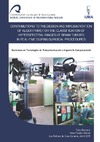Identificador persistente para citar o vincular este elemento:
https://accedacris.ulpgc.es/jspui/handle/10553/58355
| Título: | Contributions to the design and implementation of algorithms for the classification of hyperspectral images of brain tumors in real-time during surgical procedures | Autores/as: | Fabelo Gómez, Himar Antonio | Director/a : | Marrero Callicó, Gustavo Iván Sarmiento Rodríguez, Roberto |
Clasificación UNESCO: | 3314 Tecnología médica | Fecha de publicación: | 2019 | Resumen: | Hyperspectral imaging (HSI) allows the acquisition of large numbers of spectral bands throughout the electromagnetic spectrum with respect to the surface of scenes captured by sensors. Using this information and a set of complex classification algorithms, it is possible to determine which material or substance is located in each pixel. One of the major benefits of this technology is that it can be used as a guidance tool during brain tumor resections. Unlike other tumors, brain tumor infiltrates the surrounding normal brain tissue and thus their borders are indistinct and extremely difficult to identify to the surgeon’s naked eye. The surrounding normal brain tissue is critical and there is no redundancy, as in many other organs, where the tumor is commonly resected together with an ample surrounding block of normal tissue. In brain tumors, it is essential to accurately identify the margins of the tumor to resect as less healthy tissue as possible. In this sense, the work performed in this thesis aims to exploit the characteristics of HSI to develop an intraoperative demonstrator capable of performing a precise localization of malignant tumors during brain surgical procedures, expecting to improve the outcomes of the surgery. This demonstrator was able to generate thematic maps of the exposed brain surface using spectral information of the range comprised between 400 and 1000 nm, achieving intraoperative processing time (~1 min). These thematic maps distinguish between four different classes (normal tissue, tumor tissue, hypervascularized tissue and background), where the tumor boundaries can be easily identifiable. The thematic maps demonstrate that the system did not introduce false positives in the parenchymal area when no tumor was present and it was able to identify low-grade tumors that were not used to train the brain cancer detection algorithm, resulting in a robust and generalized classification algorithm. Additionally, a preliminary study to improve the accuracy results using deep learning techniques was performed. This study achieved promising results in the discrimination between tumor and normal brain tissue, being a suitable method to further improve the outcomes of the intraoperative demonstrator and, hence, the outcomes of the neurosurgical procedures. | Descripción: | Programa de doctorado: Tecnologías de Telecomunicación e Ingeniería Computacional | Instituto: | IU de Microelectrónica Aplicada | URI: | https://accedacris.ulpgc.es/handle/10553/58355 |
| Colección: | Tesis doctoral |
Visitas
316
actualizado el 24-ago-2024
Descargas
612
actualizado el 24-ago-2024
Google ScholarTM
Verifica
Comparte
Exporta metadatos
Los elementos en ULPGC accedaCRIS están protegidos por derechos de autor con todos los derechos reservados, a menos que se indique lo contrario.
